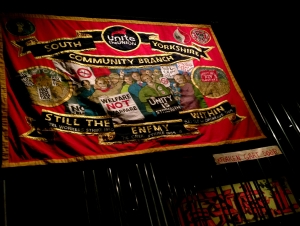As a Politics & Communication student, this term I am enrolled in Democracy and the Media, a course exploring media’s roles and responsibilities in a democratic political arena. A recent week found us digging into social movement theory, considering the strategies protest groups employ to earn media attention, mobilise supporters, and broaden the scope of conflict beyond a core group.
In our seminar session, we examined the tactics of a variety of movements, including the Suffragettes in the United Kingdom, the Zapatistas in Mexico, and Idle No More in Canada, seeking to categorise the media strategies and logic of each movement.
 A week later, my fellow students and I came face to face with objects – posters, pins, flags, and even tea cups – created by several of these movements and others similar to them at the Victoria and Albert Museum’s Disobedient Objects exhibit.
A week later, my fellow students and I came face to face with objects – posters, pins, flags, and even tea cups – created by several of these movements and others similar to them at the Victoria and Albert Museum’s Disobedient Objects exhibit.
In his book Communication as Culture, oft-cited theorist and media critic James Carey described the study of communication as an examination of “the actual social process wherein significant symbolic forms are enacted, apprehended, and used” (1989, p. 54).
Much of the exhibit’s collection dates from the 1970s to the present day, offering visitors a glimpse into the tactics utilised in an age where political conflict finds itself against the backdrop of shifting technologies. The “symbolic forms,” to use Carey’s term, on display tell the story of stances, of struggles, and, in some cases, of success.
 While the exhibit makes little distinction between protests in democratic spaces and those in non-democracies – missing, perhaps, a discussion on how those differences may impact the communication strategies of the protest movement – I believe there is value in the varied collection presented to visitors. From pins supporting the struggle against Apartheid in South Africa to shields depicting the covers of famous books protesting the closing of New York Public Library branches to stamped coins favouring the Irish Republican Army, the objects included in the collection emphasise the tremendous diversity among methods of expression. The exhibit captures the role of creativity and innovation in protest movements, while providing a welcome supplement to our class readings and discussion on the topic.
While the exhibit makes little distinction between protests in democratic spaces and those in non-democracies – missing, perhaps, a discussion on how those differences may impact the communication strategies of the protest movement – I believe there is value in the varied collection presented to visitors. From pins supporting the struggle against Apartheid in South Africa to shields depicting the covers of famous books protesting the closing of New York Public Library branches to stamped coins favouring the Irish Republican Army, the objects included in the collection emphasise the tremendous diversity among methods of expression. The exhibit captures the role of creativity and innovation in protest movements, while providing a welcome supplement to our class readings and discussion on the topic.
Our afternoon at the Victoria and Albert is another example of the incredible opportunities the city can afford its students. Learning is not restricted to the classroom, but rather takes place in conversations with peers, public lectures with distinguished speakers, and, in this case, the halls of London’s many museums.






1 Comments